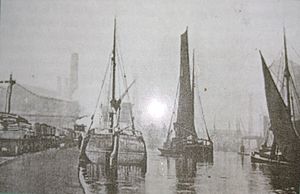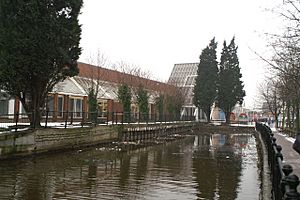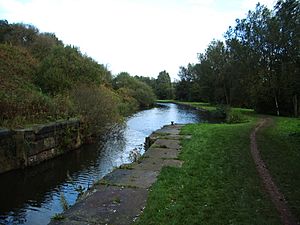Sankey Canal facts for kids
Quick facts for kids Sankey Canal |
|
|---|---|

The start of the Sankey Canal at Spike Island in Widnes
|
|
| Specifications | |
| Locks | 16 |
| Status | Partly restored |
| History | |
| Original owner | Sankey Brook Navigation Co |
| Principal engineer | Henry Berry |
| Date of act | 1755 |
| Date of first use | 1757 |
| Date closed | 1963 |
| Geography | |
| Start point | St Helens |
| End point | Widnes |
| Connects to | River Mersey |
The Sankey Canal in North West England opened in 1757. It was a very important waterway. It connected St Helens to the River Mersey. The canal ended at Spike Island in Widnes.
At first, it followed the Sankey Brook valley. It went from the Mersey through Warrington to Parr. Later, it was made longer. It reached Fiddlers Ferry and then Widnes. At the other end, it went to Sutton. Sutton is now part of St. Helens.
The canal stopped being used between 1931 and 1963. But since 1985, people have been trying to fix it up.
Contents
The Sankey Canal Story
The Sankey Canal was mainly built to move coal. Coal came from Haydock Collieries and Parr. It went to factories in Liverpool. These factories made chemicals. Iron ore and corn were also important goods.
Factories grew quickly. They spread along the canal. Small villages like St Helens and Widnes grew into towns. The canal helped these areas become industrial centers.
Planning the Canal
Henry Berry and William Taylor mapped out the canal. They were paid £66 for their work. Henry Berry was a dock engineer in Liverpool. He had worked on other canals before.
It's interesting that no one argued against building this canal. It was the first time a canal was approved so easily.
First Steps: The 1755 Act
The law to build the canal was passed on March 20, 1755. It allowed them to make Sankey Brook navigable. This meant boats could travel on it. The canal opened and started carrying coal by 1757. It cost 10 old pence per ton to move goods. This canal was Britain's very first true canal.
Besides the main route, three smaller branches were built. They went to nearby coal mines. These branches helped get coal out easily.
Expanding the Canal: The 1762 Act
Another law was passed on April 8, 1762. This law allowed the canal to be extended. It went further to Fiddler's Ferry on the River Mersey. This made it easier to connect to the river. The cost to move goods went up a little.
An early test of steam power happened on June 16, 1797. A boat carrying heavy copper slag traveled on the canal. It moved only by steam power. The boat went 10 miles and returned the same day. It used an early Newcomen engine.
Reaching Widnes: The 1830 Act
New railways started to compete with canals. So, another extension was planned. It went from Fiddler's Ferry to Widnes Wharf. This created a second link to the River Mersey. This extension was approved on May 29, 1830. Francis Giles was the engineer for this part. It opened in 1833.
How the Canal Worked
The Sankey Canal was built for "Mersey Flats." These were common sailing boats. They were used on local rivers and coasts. To let the boats' masts pass, swing bridges were built. These bridges could open to let boats through. Railways also had to cross the canal.
Near the town of Earlestown, a special bridge was built. George Stephenson built the Sankey Viaduct there. It was for the Liverpool and Manchester Railway. It was 70 feet high. This allowed the tall masts of the boats to pass underneath.
The canal was very successful at first. This led to many more canals being built. There were plans to link the Sankey Canal to other canals. But most of these plans never happened. The main extensions were to Fiddlers Ferry and Widnes.
The canal mostly carried coal from Haydock and Parr. It went to the Mersey and then to salt factories. But later, the main cargo changed. It became raw sugar. Sugar was brought from Liverpool to the Sankey Sugar Works. This factory was in Earlestown.
Over time, pollution became a problem. Factories near the canal released waste. This made the water very acidic. It even affected the boats and lock gates. In 2004, a golf course built on old waste land was closed. This was because of high levels of chemicals in the soil.
In 1845, the canal company joined with a railway company. They formed the St Helens Canal and Railway Company.
When the Canal Closed
The sugar traffic stopped in 1959. This led to the canal closing in 1963. The northern part of the canal had closed even earlier, in 1931. Fixed bridges quickly replaced the old swing bridges there.
Bringing the Canal Back to Life
Work to restore the canal started in 1980. Much of the canal still has water. Parts of it have been fixed for boats to use. Some locks into the Mersey have been repaired. This lets boats get onto the canal.
However, new fixed bridges block the way. They stop boats from traveling the whole length. The canal path is now part of the Trans Pennine Trail. This is a long walking and cycling route.
There are plans to restore more of the canal. They even hope to connect it to the main canal system. This would be a very big and expensive project. But there are also plans to dig out a filled-in section in St Helens. This is part of a town development plan.
Canal Structures
The Sankey Canal has special locks. A "staircase lock" means two locks are built right next to each other. The Old Double Lock and New Double Lock are examples. The New Double Lock was fixed in 1992. But boats cannot use it yet.
The "Seven Arches" railway bridge crosses the canal. It was built in 1873. It carries the Liverpool to Manchester railway. It has seven arches and one iron section over the canal. This bridge is 20 feet above the water. This was not high enough for the old sailing boats. It seems there might have been a way to raise the railway section. This would have let the tall masts pass.





